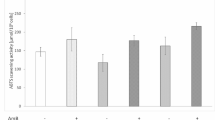Abstract
Rats injected with dimethylhydrazine for 5 weeks (DMH, 40 mg/kg body weight) invariably develop colonic cancer after a latency of some 10–14 weeks. Preliminary studies have suggested that Na+ absorption by surface colonic crypt cells is attenuated in the preneoplastic period (8–12 weeks after the first injection of DMH). The present study of glucocorticoid-treated (dexamethasone 6 mg/kg body weight, s.c. 3 days or triamcinolone 30 mg/kg body weight, s.c. 3 days) rats was undertaken to examine the ion transport properties of rat distal colon during this period in more detail. Ussing chamber studies of the distal colon and whole-cell patch-clamp measurements in surface cells, mid-crypt cells and crypt-base cells obtained from isolated crypts were performed. In Ussing chamber studies the equivalent short-circuit current inhibitable by amiloride (10 μmol/l) DMH-treated rats was about 40% of control. In addition, the hyperpolarizing effect of amiloride (10 μmol/l) on membrane voltage (V m) was strongly attenuated in surface and mid-crypt cells of DMH-treated rats. Carbachol (CCH, 100 μmol/l), which predictably hyperpolarized surface, mid-crypt cells and crypt-base cells of control rats, had no significant effect on V m in DMH-treated rats, but increased membrane conductance (G m) significantly. This indicates that CCH probably activates both Cl–and K+ channels in all three colonic crypt compartments in the DMH-treated rats. Forskolin (5 μmol/l), which has the most pronounced effect in crypt-base cells in control rats, depolarized V m and enhanced G m in all three compartments in DMH-treated rats. These data indicate that DMH profoundly alters Na+ and Cl–transport in colonic crypts prior to the appearance of colonic adenocarcinoma and that these effects can be summarized as follows: (1) the Na+ conductance of surface cells is attenuated; (2) cells along the length of the crypt-lumen axis tend to lose their normal response to CCH and instead show simultaneous and comparable increases in K+and Cl–conductances; (3) the effect of forskolin is enhanced along the entire crypt axis. As a result colonic crypt transport is shifted to predominant Cl–secretion, findings which are characteristic of colonic carcinoma cell lines such as HT29 and T84 cells.
Similar content being viewed by others
Author information
Authors and Affiliations
Additional information
Received: 13 May 1996 / Received after revision: 5 August 1996 / Accepted: 14 October 1996
Rights and permissions
About this article
Cite this article
Bleich, M., Ecke, D., Schwartz, B. et al. Effects of the carcinogen dimethylhydrazine (DMH) on the function of rat colonic crypts. Pfluegers Arch 433, 254–259 (1996). https://doi.org/10.1007/s004240050275
Issue Date:
DOI: https://doi.org/10.1007/s004240050275




